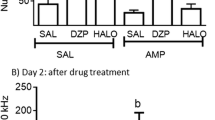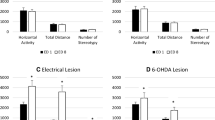Abstract
A large body of evidence supports the conclusion that mesolimbic dopaminergic neurons, particularly those that innervate the nucleus accumbens (n. ACC), are important for the expression of amphetamine-stimulated locomotor behavior (ASLB). However, a contradictory report (Wirtshafter et al. 1978), stating that bilateral lesions of the n. ACC fail to block ASLB, was based on a general measure of activity that did not distinguish between locomotion and rearing. In the present study, observer ratings of videotaped responses were used to determine the separate effects of 2.0 mg/kg d-amphetamine (d-AMP) on locomotion and rearing in rats with either sham or radio-frequency lesions of the n. ACC. The n.ACC lesions blocked the locomotor stimulation, but not the increased rearing that follows d-AMP administration. These results support the general conclusion that dopaminergic terminals in the n. ACC are important for the expression of ASLB, and further suggest that d-AMP-stimulated locomotion and rearing are mediated through different neural substrates.
Similar content being viewed by others
References
Brook C, Iversen SD (1975) Changed eating and locomotor behavior in the rat after 6-hydroxydopamine lesions of the substantia nigra. Neuropharmacology 14:95–105
Cole SO (1978) Brain mechanisms of amphetamine-induced anorexia, locomotion, and stereotypy: A review. Neurosci Biobehav Rev 2:89–100
Costall B, Marsden CD, Naylor RJ, Pycock CJ (1977) Stereotyped behavior patterns and hyperactivity induced by amphetamine and apomorphine after discrete 6-hydroxydopamine lesions of extrapyramidal and mesolimbic nuclei. Brain Res 123:89–111
Fink JS, Smith GP (1979) Abnormal pattern of amphetamine locomotion after 6-OHDA lesion of anteromedial caudate. Pharmacol Biochem Behav 11:23–30
Fog R (1972) On stereotypy and catalepsy: Studies on the effect of amphetamines and neurolepties in rats. Acta Neurol Scand 48 Suppl 50:1–66
Fray PJ, Sahakian BJ, Robbins TW, Koob GF, Iversen SD (1980) An observational method for quantifying the behavioral effects of dopamine agonists: contrasting effects of d-amphetamine and apomorphine. Psychopharmacology 69:253–259
Groves PM, Rebec GV (1976) Biochemistry and behavior: Some central actions of amphetamine and antipsychotic drugs. Annu Rev Psychol 27:91–111
Haber S, Hatsukami T, Berger PA, Barchas JD, Akil H (1978) Naloxone blocks amphetamine-induced rearing: Potential interaction between catecholamines and endorphins. Prog Neuropsychopharmacology 2:425–430
Hodge GK, Boyeson MG, Linn RT (1981) Dopaminergic agonists differentially affect open-field reactivity of rats with A10 lesions. Psychopharmacology 73:39–42
Horlington M (1970) Startle response circadian rhythm in rats: Lack of correlation with motor activity. Physiol Behav 5:49–53
Iversen SD, Koob GF (1977) Behavioral implication of dopaminergic neurons in the mesolimbic system. In: Costa E, Gessa GL (eds) Advances in biochemical psychopharmacology, vol XXXI. Raven, New York, pp 209–214
Jackson DM, Andén NE, Dahlstrom A (1975) A functional effect of dopamine in the nucleus accumbens and in some other dopaminerich parts of the rat brain. Psychopharmacologia 45:139–149
Kelly PH, Seviour PW, Iversen SD (1975) Amphetamine and apomorphine responses in the rat following 6-OHDA lesions of the nucleus accumbens septi and corpus striatum. Brain Res 94:507–522
Kelly PH, Iversen SD (1976) Selective 6-OHDA-induced destruction of mesolimbic dopamine neurons: Abolition of psychostimulantinduced locomotor activity in rats. Eur J Pharmacol 40:45–56
Koob GF, Riley SJ, Smith SC, Robbins TW (1978) Effects of 6-hydroxydopamine lesions of the nucleus accumbens septi and olfactory tubercle on feeding, locomotor activity, and amphetamine anorexia in the rat. J Comp Physiol Psychol 92:917–927
Lemmer B, Berger T (1978) Diurnal rhythm in the central dopamine turnover in the rat. Naunyn-Schmiedebergs Arch Pharmacol 303:257–261
Lorens SA, Sorensen JP, Harvey JA (1970) Lesions in the nuclei accumbens septi of the rat: Behavioral and biochemical effects. J Comp Physiol Psychol 73:284–290
Mumford L, Teixeira AR, Kumar R (1979) Sources of variation in locomotor activity and stereotypy in rats treated with d-amphetamine. Psychopharmacology 62:241–245
Pellegrino LJ, Cushman AJ (1967) A stereotaxic atlas of the rat brain. Meredith, New York
Pijnenburg AJJ, Honig WMM, van Rossum JM (1975) Antagonism of apomorphine- and d-amphetamine-induced locomotor activity by injection of haloperidol into the nucleus accumbens of the rat. Psychopharmacologia 41:87–95
Robbins TW (1977) A critique of methods available for the measurement of spontaneous motor activity. In: Iversen LL, Iversen SD, Snyder SH (eds) Handbook of psychopharmacology, vol II. Plenum, New York, pp 37–83
Russell RL, Pihl RO (1978) The effect of dose, novelty, and exploration on amphetamine-produced stereotyped behavior. Psychopharmacology 60:93–100
Schiorring E (1979) An open field study of stereotyped locomotor activity in amphetamine-treated rats. Psychopharmacology 66:281–287
Segal DS (1975) Behavioral characterization of d-and l-amphetamine: Neurochemical implications. Science 190:475–477
Sessions GF, Meyerhoff JL, Kant GJ, Koob GF (1980) Effects of lesions of the ventral medial tegmentum on locomotor activity, biogenic amines, and response to amphetamine in rats. Pharmacol Biochem Behav 12:603–608
Teitelbaum H, Giammatteo P, Mickley GA (1979) Differential effects of localized lesions of n. accumbens on morphine- and amphetamine-induced locomotor hyperactivity in the C57 BL/6J mouse. J Comp Physiol Psychol 93:745–751
Ungerstedt U (1971) Stereotaxic mapping of the monoamine pathways in the rat brain. Acta Physiol Scand (Suppl) 367:1–48
van Rossum JM, Broekkamp CLE, Pijnenburg AJJ (1977) Behavioral correlates of dopaminergic function in the nucleus accumbens. In: Costa E, Gessa Gl (eds) Advances in biochemical psychopharmacology, vol XXXI. Raven, New York, pp 201–207
Wirtshafter D, Asin KE, Kent EW (1978) Nucleus accumbens lesions reduce amphetamine hyperthermia, but not hyperactivity. Eur J Pharmacol 51:449–452
Author information
Authors and Affiliations
Rights and permissions
About this article
Cite this article
Kehne, J.H., Sant, W.W. & Sorenson, C.A. The effects of radio-frequency lesions of the nucleus accumbens on d-amphetamine-induced locomotor and rearing behavior in rats. Psychopharmacology 75, 363–367 (1981). https://doi.org/10.1007/BF00435854
Received:
Accepted:
Issue Date:
DOI: https://doi.org/10.1007/BF00435854




